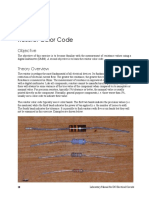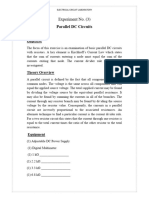Experiment 7
Experiment 7
Uploaded by
Luis Fernando PinedaCopyright:
Available Formats
Experiment 7
Experiment 7
Uploaded by
Luis Fernando PinedaOriginal Description:
Copyright
Available Formats
Share this document
Did you find this document useful?
Is this content inappropriate?
Copyright:
Available Formats
Experiment 7
Experiment 7
Uploaded by
Luis Fernando PinedaCopyright:
Available Formats
EE 3301 Section 501 Experiment 7 Respond of RLC Circuits Luis Pineda-Aguirre Son Nguyen November 12, 2013
Resistors in Series:
In the first part of the lab we used 3 1/8 watt standard carbon based resistors 5.6k Ohm (green, blue, red), 2.2k (red, red, red), 1k (brown, black, red). We created a DC circuit with a voltage source of 10V and the three resistors connected in series. The schematic is shown below in figure 1. The comparison between theoretical and measured values is shown in Tables 1. In the first table a breadboard and a Agilent E3631A Triple Output DC Power Supply were used to simulate the circuit and the circuit was measured with the Digit Multimeter.
Figure 1: Resistors in series.
Results:
8.8 10 1.13 2.5 6.36 1.13 Experimental .95 2.19 5.5 8.59 0 1.12 2.5 6.3 1.16 %Error 0 .8 5 .4 1.7 2.3 0 .9 -2.6
Table 1: Resistors in series. Parameter Units Theoretical R1 1 R3 k 2.2 5.6 R2 Req Vs VR 1 VR 2 V VR 3 Is mA
Analysis:
The tables show that the resistors have different values. For example, in the 1k Ohm resistor, the Digit Multimeter measured .9k Ohm. But the measurements are between the +- 5% tolerance value band of a resistor. The resistance equivalent was measured by adding resistors in series. Since the measured resistors were a little smaller than the theoretical values the resistance equivalent was 2.3 percent lower. The current flow was found by (Is= Vs/Req). Like the resistance equivalent, the current flow its a little lower because of the resistors with 2.6 difference. With the current we measured the voltage drop of each resistor.
Resistors in Parallel:
In the second part of the lab we used 3 1/8 watt standard carbon based resistors 1.5k Ohm (brown, green, red), 6.8k (blue, grey, red), 8.2k (grey, red, red). We created a DC circuit with a voltage source of 10V and the three resistors connected in parallel. The schematic
is shown below in figure 2. The comparison between theoretical and measured values is shown in Tables 2. In the first table a breadboard and an Agilent E3631A Triple Output DC Power Supply were used to simulate the circuit and the circuit was measured with the Digit Multimeter.
Table 2: Resistors in parallel
Results:
Parameter Units Theoretical Experimental %Error R1 1.5 R3 k 6.8 8.2 R2 Req Vs V 10 0 0 I R1 I R2 I R3 mA Is
1.068 1.47 6.7 8.1 1.04 2 1.4 1.2 2.6
Table 2: Resistors in parallel.
6.7 1.47 1.22 9.3 6.8 1.49 1.23 9.5 6 -1.5 -1.3 -.8 -3.2
Analysis:
The tables show that the resistors have different values. For example, in the 1.5k Ohm resistor, the Digit Multimeter measured 1.47k Ohm. But the measurements are between the +- 5% tolerance value band of a resistor. The resistance equivalent was measured by adding resistors in parallel. Since the measured resistors were a little smaller than the theoretical values the resistance equivalent was 2.6 percent lower. The current flow was found by (Is= Vs/Req). Like the resistance equivalent, the current flow its a little lower because of the resistors with 2.6 differences. With the voltage we measure the current flow on each resistor.
Resistors in series-parallel combination:
In the third part of the lab we used 3 1/8 watt standard carbon based resistors 2.2k (red, red, red), 1k (brown, black, red), .6k Ohm (green, blue, red), 8.2k (grey, red, red). We created a DC circuit with a voltage source of 10V and two groups of two resistors connected in parallel each and the groups are connected in series. The schematic is shown below in figure 3. The comparison between theoretical and measured values is shown in Tables 3. In the first table a breadboard and an Agilent E3631A Triple Output DC Power Supply were used to simulate the circuit and the circuit was measured with the Digit Multimeter.
Table 3: Series-Parallel combination.
Results:
Param R1 R2 R3 R4 Ra c Vab Unit Theor 1.0 2.2 5.6 8.2 Exper %Error Param I R1 I R2 I R3 I R4 Is Vbc Unit Theor Exper %Error
.95 2.19 5.5 8.1 4.01 3.91 1.71 1.71
5 .4 1.7 1.2 2.61 0
1.5 .68 mA 1.3 .892 2.2 V 8.28
1.8 .75 1.54 1.05 2.6 8.28
-20 -10 -18 -17 -18 0
Analysis:
The tables show that the resistors have different values. For example, in the 1k Ohm resistor, the Digit Multimeter measured .9k Ohm. But the measurements are between the +- 5% tolerance value band of a resistor. The resistance Ra-c was measured by adding in parallel R3 and R4. And adding in parallel R1 and R2. Then the resistors were adding together. equivalent was measured by adding resistors in parallel. By KVL we can say that Vab = Vs - Vbc . By KCL we can say that Is = IR1 + IR2 = IR3 + IR4 . The error percentage of the currents in all the resistors is really low. They exceed the maximum margin of error. The measurements might be wrong due to the error given by the multimiter and the resistance error from each resistor.
Voltage, Current Divider and Wheatstone Bridge:
Figure 4: voltage divider.
Figure 5: Current divider.
Figure 6: Wheatstone bridge.
Parameter Units Theoretical Experimental %Error
R2 k 2.2 1.8
R1
Vs V 10 0 0
Vo 4.5
2.19 1.78 .4 1.1
4.4 2.2
Table 4: Voltage divider. Parameter Units Theoretical Experimental %Error RL k 2.2 1.8 R1 IL mA 10 5.5 0 5.5 0 0 Is
2.19 1.78 .45 1.1
Table 5: Current divider.
Parameter Units Theoretical
R1 2.4
R3 k 2.4 2.4
R2
R4
Vs
5.6
Vab V 10 -2
Experimental %Error
2.3 2.3 2.3 5.6 4.1 4.1 4.1 0
0 0
-3 50
Table 6: Wheatstone bridge.
Analysis
4. A voltage divider can provide a voltage at its output, but it cannot provide current. If a device is connected to the output of a voltage divider, what value of resistance should it have? Only an infinite value of resistance at the load will not change the voltage divider output. Or allowing a 1% error, the load has to be at least 100 times higher than the equivalent resistance of the divider. 5. In a Wheatstone bridge, assume R1 =2R2 and R3 =2R4 . What is the value of Vab ? The value of Vab would be zero.
You might also like
- Voltage and Current Division Lab Report PDFDocument9 pagesVoltage and Current Division Lab Report PDFSimile Rhino Mhlanga89% (18)
- Lab E1 RLC Circuit 1Document11 pagesLab E1 RLC Circuit 1Ching Wai Yong100% (2)
- Eec 115 Practical - Electrical EngineeringDocument35 pagesEec 115 Practical - Electrical EngineeringVietHungCao90% (10)
- Sony KDL-50R550A Chassis RB1FK-BLDocument50 pagesSony KDL-50R550A Chassis RB1FK-BLLeonel A. Hernandez100% (1)
- Ecler Nuo3 SMDocument32 pagesEcler Nuo3 SMDJ JAMNo ratings yet
- EEC 115 Electrical Engg Science 1 PracticalDocument29 pagesEEC 115 Electrical Engg Science 1 PracticalNwafor Timothy100% (10)
- 203 Lab04 Circuits Sum08 PDFDocument6 pages203 Lab04 Circuits Sum08 PDFJun MendozaNo ratings yet
- Urdaneta City University College of Engineering and ArchitectureDocument10 pagesUrdaneta City University College of Engineering and Architecturezed cozNo ratings yet
- Exp 2 Resistors, Ohm's Law, Power Rating and I-V Caharacteristic (2012)Document10 pagesExp 2 Resistors, Ohm's Law, Power Rating and I-V Caharacteristic (2012)usmpowerlabNo ratings yet
- Design of A Small Flight Control SystemDocument120 pagesDesign of A Small Flight Control SystemRuben RubenNo ratings yet
- Lab E1 RLC CircuitDocument11 pagesLab E1 RLC CircuitChing Wai Yong100% (1)
- Resistor Color Code: ObjectiveDocument9 pagesResistor Color Code: ObjectiveEdgar RodríguezNo ratings yet
- Lab 3 Report FinalDocument13 pagesLab 3 Report FinalrajNo ratings yet
- Lab #1Document25 pagesLab #1Ryan Shea0% (2)
- BE Lab ReportDocument63 pagesBE Lab ReportArenNo ratings yet
- ET304A Electric Circuits Laboratory Lab 1 Kirchhoff's Voltage and Current LawsDocument4 pagesET304A Electric Circuits Laboratory Lab 1 Kirchhoff's Voltage and Current LawsJoshua MendozaNo ratings yet
- Group 5 - Laboratory No. 5Document14 pagesGroup 5 - Laboratory No. 5Angel GonzalesNo ratings yet
- Series and Parallel Resistors Virtual Experiment-Spring 2020-Virtual-StudentDocument8 pagesSeries and Parallel Resistors Virtual Experiment-Spring 2020-Virtual-Studentfaisal alkamali100% (1)
- EE204 LabDocument37 pagesEE204 LabKrishnaveni Subramani SNo ratings yet
- Lab 3 (Nodal Analysis)Document8 pagesLab 3 (Nodal Analysis)anon_938313424No ratings yet
- Lab Manual EE852Document20 pagesLab Manual EE852Uzair Ul HaqNo ratings yet
- EXP.1-Basic Ohm's LawDocument17 pagesEXP.1-Basic Ohm's LawEbtehal RassaNo ratings yet
- 205b Lab 09Document2 pages205b Lab 09thecyberchimpNo ratings yet
- 107 ManualDocument69 pages107 ManualhaimiryazNo ratings yet
- Electric Circuits ODL Manual 1-1Document6 pagesElectric Circuits ODL Manual 1-1Idk Maybe AwaisNo ratings yet
- Experiment 7 FinalDocument11 pagesExperiment 7 Finalernie5000No ratings yet
- Circuits Lab Exp 6 ReportDocument24 pagesCircuits Lab Exp 6 ReportAniqNo ratings yet
- EXP. 3 Parallel DC CircuitDocument4 pagesEXP. 3 Parallel DC CircuitghlafhlyNo ratings yet
- Impedance of RL Circuits: Series RL Circuits: Experiment No. 2Document16 pagesImpedance of RL Circuits: Series RL Circuits: Experiment No. 2NicoNo ratings yet
- BE.01.08 Series Resistive Circuits SHDocument12 pagesBE.01.08 Series Resistive Circuits SHleslynjdNo ratings yet
- Laboratory Exercise 5 Malabanan, Clarenz Medina 2BSMEDocument6 pagesLaboratory Exercise 5 Malabanan, Clarenz Medina 2BSMEJarish Nacilo-anNo ratings yet
- Lab 1Document11 pagesLab 1Fatin ChowdhuryNo ratings yet
- Circuits Lab Exp 5 ReportDocument17 pagesCircuits Lab Exp 5 Reportਰਣਜੀਤ ਢਿੱਲੋਂNo ratings yet
- Experiment 8 Result and DiscussionDocument3 pagesExperiment 8 Result and DiscussionLemuel ValerioNo ratings yet
- Laboratory Experiment No. 3 Group 2 EE2203B 1Document20 pagesLaboratory Experiment No. 3 Group 2 EE2203B 1Alzen Galpao Enage100% (1)
- University of The East - Caloocan College of Engineering: Series and Parallel Circuits Experiment No. 2Document12 pagesUniversity of The East - Caloocan College of Engineering: Series and Parallel Circuits Experiment No. 2Jabber Reyes AmborNo ratings yet
- EE131.1 LabDocument40 pagesEE131.1 LabMarc MontillaNo ratings yet
- Semiconductors and Amplifiers LabDocument18 pagesSemiconductors and Amplifiers LabDurshil MungraNo ratings yet
- EF - I Practical Procedure SheetsDocument22 pagesEF - I Practical Procedure SheetsEshwar HarshithNo ratings yet
- Electrical Protection 801 MadunaDocument16 pagesElectrical Protection 801 MadunaSandile MadunaNo ratings yet
- Circuits I Lab 1 Post ReportDocument14 pagesCircuits I Lab 1 Post ReportGreg KeenerNo ratings yet
- Lab1 - Manuel AbadieDocument6 pagesLab1 - Manuel AbadieManuel Abadie0% (1)
- Class: CC08 / Group: 1B Lecturer s comment Full name: 1) Nguyễn Quốc Minh Thư 2) Nguyễn Trần Minh Phước 3) Nguyễn Hoàng Anh Thư 4) Trần Trang Kỳ Phong 5) Nguyễn Công ĐạtDocument10 pagesClass: CC08 / Group: 1B Lecturer s comment Full name: 1) Nguyễn Quốc Minh Thư 2) Nguyễn Trần Minh Phước 3) Nguyễn Hoàng Anh Thư 4) Trần Trang Kỳ Phong 5) Nguyễn Công ĐạtDũng AnhNo ratings yet
- Unit 1: DC Circuits: Summary and Learning OutcomesDocument12 pagesUnit 1: DC Circuits: Summary and Learning OutcomesKevin CheeNo ratings yet
- Ac S PDocument75 pagesAc S PRakesh Kumar DNo ratings yet
- Exp 6Document12 pagesExp 6Laura AcaciaNo ratings yet
- Lab 5 (Loading Effects)Document17 pagesLab 5 (Loading Effects)Khairi KKamarNo ratings yet
- ECE 11.1 Lab ManualDocument46 pagesECE 11.1 Lab ManualRoselle Joy Dela CruzNo ratings yet
- Series ParallelDocument4 pagesSeries ParallelYael ManlangitNo ratings yet
- Experiment #5: Parallel CircuitsDocument7 pagesExperiment #5: Parallel CircuitsJustine G. ViñasNo ratings yet
- Report On Basic Ohm S Law Series and Parallel Circuits PDFDocument18 pagesReport On Basic Ohm S Law Series and Parallel Circuits PDFhaikal100% (1)
- EXP. 2 Series DC CircuitDocument4 pagesEXP. 2 Series DC CircuitghlafhlyNo ratings yet
- Circuits Lab Exp 2 ReportDocument15 pagesCircuits Lab Exp 2 ReportEdamEdamNo ratings yet
- Experiment # - 1Document6 pagesExperiment # - 1Ahmad ALzaabiNo ratings yet
- Electronics Engineering Program - PUPSTB ECEN 30012 Basic Electronics 1 Experiment #4: Parallel Circuit - Voltage and Current Measurement PrelabDocument4 pagesElectronics Engineering Program - PUPSTB ECEN 30012 Basic Electronics 1 Experiment #4: Parallel Circuit - Voltage and Current Measurement PrelabJewel Lim100% (1)
- Ohm's LawDocument7 pagesOhm's Lawfisicacurso1No ratings yet
- Experiment 3: To Verify Kirchhoff's Voltage and Current Laws ExperimentallyDocument3 pagesExperiment 3: To Verify Kirchhoff's Voltage and Current Laws ExperimentallyWaseem HaiderNo ratings yet
- Sulaimani Polytechnic University Engineering Technical College Communication DepartmentDocument12 pagesSulaimani Polytechnic University Engineering Technical College Communication Departmentsarkar salamNo ratings yet
- 11 Ohm's Law CapstoneDocument8 pages11 Ohm's Law CapstoneVihan AwNo ratings yet
- Electrical Systems 100 Lab 2Document14 pagesElectrical Systems 100 Lab 2Aj PerksNo ratings yet
- IEC - Lab Exp 3Document12 pagesIEC - Lab Exp 3sazidmohsin456No ratings yet
- XPIC TutorialDocument3 pagesXPIC TutorialNnaji Maurice100% (1)
- IOA RS12 An Electroacoustic Network SimulatorDocument8 pagesIOA RS12 An Electroacoustic Network SimulatorPaul BergNo ratings yet
- Data SheetDocument13 pagesData Sheethukam pariharNo ratings yet
- N Tata Fir PDFDocument2 pagesN Tata Fir PDFBranza GeorgeNo ratings yet
- 6330.LF Antenna DesignDocument38 pages6330.LF Antenna DesignΔΗΜΗΤΡΗΣ ΦΩΤΙΑΔΗΣNo ratings yet
- Design of A Low-Power Low-Cost UHF RFID Reader ModDocument10 pagesDesign of A Low-Power Low-Cost UHF RFID Reader ModNikhil ShahNo ratings yet
- 160.54-m1 Micro Board DataDocument24 pages160.54-m1 Micro Board Dataazam chohhan100% (1)
- GBJ15M Diode Cau Chinh Luu PDFDocument4 pagesGBJ15M Diode Cau Chinh Luu PDFHưng HQNo ratings yet
- Of For: Static Industrial Turuine-GeneratorsDocument9 pagesOf For: Static Industrial Turuine-GeneratorsMartua MarioNo ratings yet
- A Step-Up Switched-Capacitor MultilevelDocument1 pageA Step-Up Switched-Capacitor MultilevelAnney RevathiNo ratings yet
- Cxa VVVF 220Document1 pageCxa VVVF 220Mohamed ArefNo ratings yet
- 74HC HCT157Document15 pages74HC HCT157TraceExpo PVT LTDNo ratings yet
- Williams 08 - NSC Application NotesDocument160 pagesWilliams 08 - NSC Application NotesGabriel PalomoNo ratings yet
- TC4066BF TC4066BP en Datasheet 071001Document11 pagesTC4066BF TC4066BP en Datasheet 071001Juan_Manuel_Ut_2909No ratings yet
- Result - Final (Annexure - I) - 923680Document25 pagesResult - Final (Annexure - I) - 923680patelsandip1989No ratings yet
- FYPDocument32 pagesFYPSadique Mohamed SalihNo ratings yet
- 74HC133Document10 pages74HC133jnax101No ratings yet
- Thesis Project Window With PasswardDocument69 pagesThesis Project Window With Passwardeyob degemuNo ratings yet
- LTV-357T Series-TransistorDocument12 pagesLTV-357T Series-TransistorJulian Andres SierraNo ratings yet
- STM32L052x6 STM32L052x8Document150 pagesSTM32L052x6 STM32L052x8Emmanuel JaffrotNo ratings yet
- Industrial Drives and Control Systems EETDocument3 pagesIndustrial Drives and Control Systems EETAyu TfrNo ratings yet
- Program To Interface GSM Modem With PIC18F4550 MicrocontrollerDocument4 pagesProgram To Interface GSM Modem With PIC18F4550 MicrocontrollerArun Kumar100% (3)
- 03 - Statron Technical Datasheet - Item 3.0-DikonversiDocument16 pages03 - Statron Technical Datasheet - Item 3.0-DikonversiteleangNo ratings yet
- The TriacDocument1 pageThe TriacMuhammad SaadNo ratings yet
- Strato 70W LED Power Supplies :: ROAL Living EnergyDocument4 pagesStrato 70W LED Power Supplies :: ROAL Living EnergyroalscribdNo ratings yet
- SyllabusDocument2 pagesSyllabusformyphdNo ratings yet
























































































